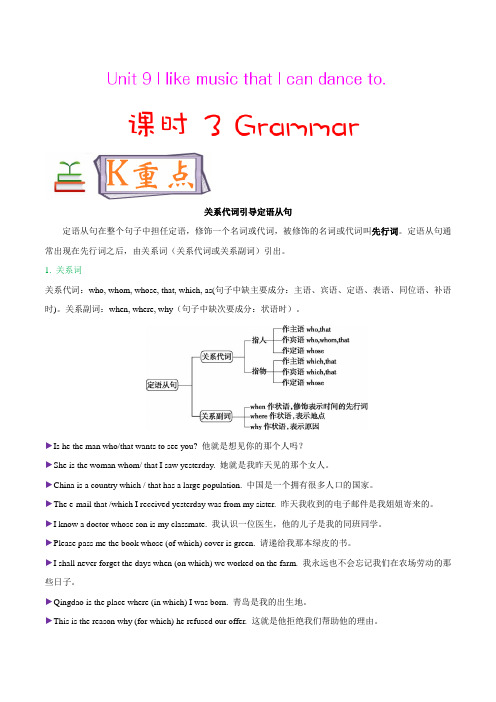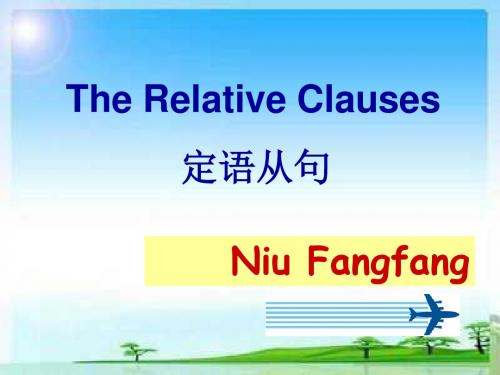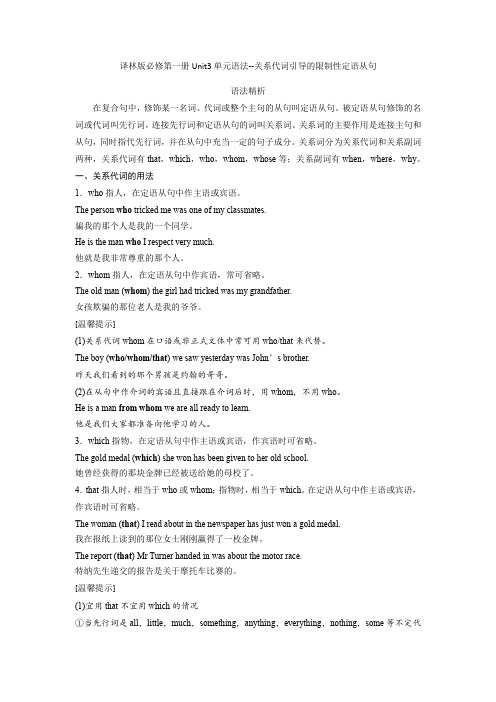Grammar---讲义定语从句
- 格式:ppt
- 大小:2.49 MB
- 文档页数:48


关系代词引导定语从句定语从句在整个句子中担任定语,修饰一个名词或代词,被修饰的名词或代词叫先行词。
定语从句通常出现在先行词之后,由关系词(关系代词或关系副词)引出。
1. 关系词关系代词:who, whom, whose, that, which, as(句子中缺主要成分:主语、宾语、定语、表语、同位语、补语时)。
关系副词:when, where, why(句子中缺次要成分:状语时)。
►Is he the man who/that wants to see you? 他就是想见你的那个人吗?►She is the woman whom/ that I saw yesterday. 她就是我昨天见的那个女人。
►China is a country which / that has a large population. 中国是一个拥有很多人口的国家。
►The e-mail that /which I received yesterday was from my sister. 昨天我收到的电子邮件是我姐姐寄来的。
►I know a doctor whose son is my classmate. 我认识一位医生,他的儿子是我的同班同学。
►Please pass me the book whose (of which) cover is green. 请递给我那本绿皮的书。
►I shall never forget the days when (on which) we worked on the farm. 我永远也不会忘记我们在农场劳动的那些日子。
►Qingdao is the place where (in which) I was born. 青岛是我的出生地。
►This is the reason why (for which) he refused our offer. 这就是他拒绝我们帮助他的理由。



译林版必修第一册Unit3单元语法--关系代词引导的限制性定语从句语法精析在复合句中,修饰某一名词、代词或整个主句的从句叫定语从句。
被定语从句修饰的名词或代词叫先行词,连接先行词和定语从句的词叫关系词。
关系词的主要作用是连接主句和从句,同时指代先行词,并在从句中充当一定的句子成分。
关系词分为关系代词和关系副词两种,关系代词有that,which,who,whom,whose等;关系副词有when,where,why。
一、关系代词的用法1.who指人,在定语从句中作主语或宾语。
The person who tricked me was one of my classmates.骗我的那个人是我的一个同学。
He is the man who I respect very much.他就是我非常尊重的那个人。
2.whom指人,在定语从句中作宾语,常可省略。
The old man (whom) the girl had tricked was my grandfather.女孩欺骗的那位老人是我的爷爷。
[温馨提示](1)关系代词whom在口语或非正式文体中常可用who/that来代替。
The boy (who/whom/that) we saw yesterday was John’s brother.昨天我们看到的那个男孩是约翰的哥哥。
(2)在从句中作介词的宾语且直接跟在介词后时,用whom,不用who。
He is a man from whom we are all ready to learn.他是我们大家都准备向他学习的人。
3.which指物,在定语从句中作主语或宾语,作宾语时可省略。
The gold medal (which) she won has been given to her old school.她曾经获得的那块金牌已经被送给她的母校了。
4.that指人时,相当于who或whom;指物时,相当于which。

Section ⅢGrammar——定语从句(Ⅱ)语境自主领悟先观察原句后自主感悟①In the corner,there is a garbage canaround which are pieces of garbage andwaste paper.②My cousin is a person with whom Istayed when I was young.③I often think of the moment when I firstsaw her.④Perhaps there is a reason why thehouse is in a mess.⑤Mike wants to work in a country wherethere are a lot of forests.1.例句①②中含“介词+关系代词”引导的定语从句,而且关系词作介词的宾语。
2.例句③④⑤中含关系副词引导的定语从句,而且,关系副词在从句中作状语。
why作原因状语;where作地点状语;when作时间状语。
一、“介词+关系代词”引导的定语从句1.在“介词+关系代词”引导的定语从句中,关系代词通常是which和whom,which指物,whom指人。
[即时训练1]用“介词+关系代词”引导的定语从句合并句子①The reason is that he was ill yesterday.He did not hand in his homework for that reason.→The reason for which he did not hand in his homework is that he was ill yesterday.②The English play was a great success.The students acted in it at the New Year's party.→The English play in which the students acted at the New Year's party was a great success.③Who is the man?You shook hands with him just now.→Who is the man with whom you shook hands just now?2.“介词+which”在定语从句中作时间、地点、原因状语,相当于关系副词when,where,why。
译林版必修第一册Unit4单元语法--关系副词引导的限制性定语从句语法精析当先行词在定语从句中作状语时,通常要用关系副词引导定语从句。
常用的关系副词有where,when,why等。
1.关系副词wherewhere引导的定语从句的先行词往往是表示地点的名词(如place,room,house,spot等),关系副词在从句中作地点状语。
常用in which,at which,on which等代替。
They are playing in the park where(=in which) there are some flowers.他们正在有花的公园里玩耍。
The office where(=at which) the girl works is not far from here.这个女孩工作的办公室离这儿不远。
[温馨提示]①有一些先行词,如point,stage,position,case,condition等,属于抽象的地点名词,如果定语从句中缺状语,需要接where引导的定语从句。
You reach a point in your project where you just want to get the thing f inished.从事任何项目你都会进入一种境界:一心想完成它。
We reached a stage where we had to answer violence with violence.我们陷入了必须用暴力来对抗暴力的境地。
②where引导定语从句和状语从句的区别:引导定语从句时,where是关系副词,在从句中作地点状语,其前有表示地点的名词作先行词,从句修饰先行词;引导状语从句时,where是从属连词,从句修饰主句的谓语动词,where前面没有表示地点的名词。
He’s got into a situation where he is likely to lose control over the plane.(定语从句)他陷入了一种很可能会失去对飞机的控制的境地。
The analysis of the teaching materialThis period is about the Grammar----Review attributive clauses. Before this module, we have learned the usage of atttibutive clauses in Book 3. The grammar is very important in learning English. So in this lesson,we’ll review attributive clauses and do some related exercises. If the students grasp it well, they’ll learn the rest of this module easily.Teaching Aims:(一)Knowledge and Skills1. Have a deep understanding of the significance and the importance of this grammar2. Improve the students’ ability to use this grammar freely(二)Emotion, attitude and valueGuide the students to cooperate with others by working in groups. They can help each other and learn from each other.And also train their sense of team work.Teaching important points: The structure and usage of attributive clauseTeaching difficult points: How to use attributitve clause freely Judge the difference between Restrictive Attributive clause and Non-Restrictive Attributive clauseTeaching type: RevisionTeaching methods: questioning, guiding, practicing and discussing Teaching aids: chalk, blackboard, book, notes, and exercise Teaching procedures:Step 1: : Presentation (20)Purpose: To get Ss to know the teaching content of GrammarIn this step, I’ll ask students to recall the attributive clause,and then pick up 4 students to present their answers to us.(5)While they are answering , I’ll make a supplement and stress on the important points.Show the following contents on blackboard or PowerPoint.Attributive clausesFirstly, the structure of attributive clause isantecedents+relative pronouns or adverbs+clause Secondly, what are the relative pronouns and adverbs?e.g who, whom, whose,which, that, when, where, why.How to use them in the attributive clause? Now, let’s look at the following sentences.e.g She is the old woman whom I saw this morning.In this sentence ,whom reffers to the old woman and at the same time acts as the object of “saw”.Thirdly , “prep+ relative words”Look at the following two simple sentencses and combind them into one sentence with this structure.For example,The box is full of bottles. He is standing on the box.----> The box on which he is standing is full of bottles.The box where he is standing is full of bottles.Fourth, the difference between Restrictive attributive clause and Non-restrictive attributive clauseWith the RAC deleted, the meaning of the whole sentence will change. But if the N-RAC is deleted, it won’t influence on the meaning of the whole sentence.Step 2 Practice (15)Purpose: To get Ss to have knowledge of the grammar through exercises.一Individually Work1.Ask students to read the five sentences in activity 1 to find out the all antecedents。
Grammar:The Attributive Clause 语法:定语从句定语从句:在复合句中修饰名词或代词、充当定语的句子叫定语从句。
因其功能相当于形容词,所以又称为形容词性从句。
先行词:被定语从句所修饰的名词或代词。
关系词:引导定语从句的词,也叫引导词。
分为关系代词(who,whom,that,which,whose , as)和关系副词(where,when,why)。
关系词要在定语从句中作某个成分,如主语、宾语等。
限制性定语从句:对先行词起修饰限定作用的定语从句。
非限制性定语从句:对先行词或主句起补充说明作用的定语从句,通常是引导词和先行词之间用逗号隔开。
This is our school where we live and study every day.Find out the relative pronouns (找出关系代词)1. The teachers who are present at our class are all experienced teachers.2. Our class is a big family which consists of 33 girls and 32 boys.3. This is the boy whose English is very good in our class.4. The school where we are studying is very beautiful.5. As we all know, our school is 9 years old.关系词及其意义考点与难点归纳:1.that与which2.对the way的考查3.介词+关系词4.as的使用5.对where的考查6.综合考查考点1:that 与 which高考真题链接:(2007年高考湖北卷第34题)Last night, John was answering the letters ___________________(寄给他的)during th e past two weeks.(arrive)只用that不用which的情况:1:先行词是everything, nothing, anything, much, little, none等不定代词或由不定代词an y, some, no, much, few,little, every, all等修饰时, 引导定语从句用that不用which。